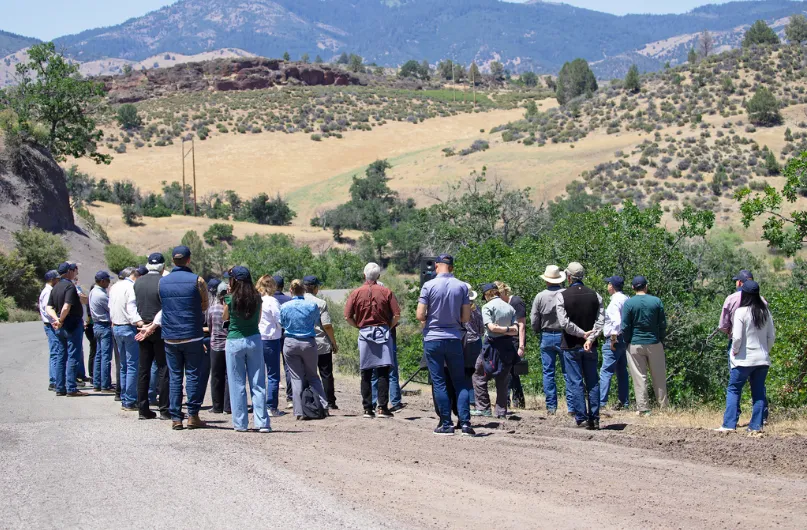
From the road that ran alongside the former Iron Gate Reservoir, members of the UC President’s Advisory Commission on Agriculture and Natural Resources and the UC ANR Governing Council looked down at a narrow channel of the Klamath River flowing through what used to be the bottom of the reservoir. This began the first of several stops throughout Siskiyou County on June 17 and 18 to learn how UC Cooperative Extension and UC ANR’s Intermountain Research and Extension Center work with the community to solve local issues. In addition to hearing from several UC Cooperative Extension advisors, they also met many local partners.
“We couldn’t deliver our mission without local partners,” Vice President Glenda Humiston told the PAC and Governing Council members.
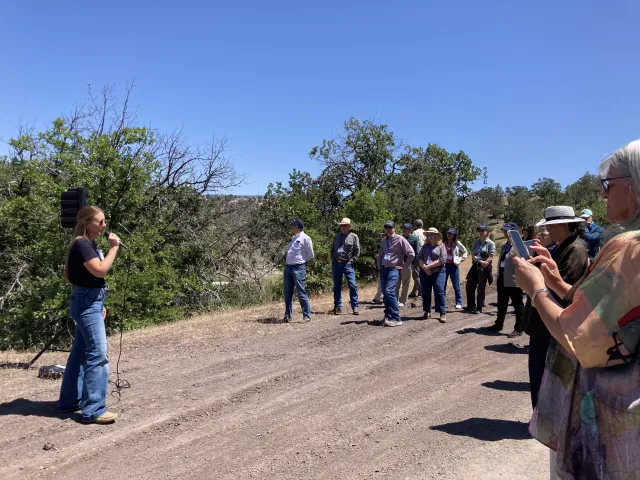
Grace Woodmansee, director of UCCE in Siskiyou County and livestock and natural resources advisor, welcomed the 36 visitors and provided some background about the region and introduced local partners. They discussed the complicated history of the Klamath River, visited Pastures of Grace Ranch operated by the Klever family, were briefed about forest management, California’s wolf population and wildfire, then toured Intermountain Research and Extension Center.
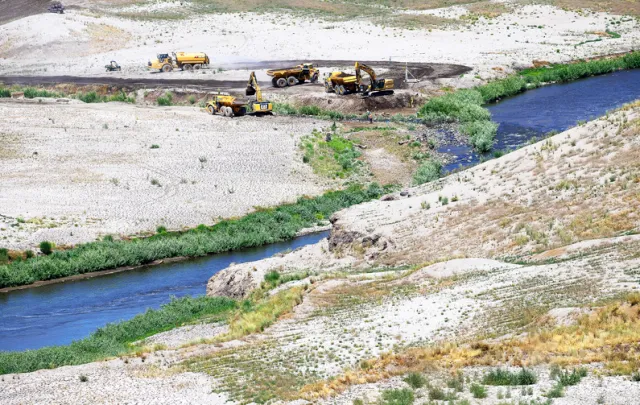
Results of removing Klamath River dams
For the first stop, the group visited the site of Iron Gate Dam – one of four dams the nonprofit Klamath River Renewal Corporation removed from the lower Klamath River between 2022 and 2024. They could see green vegetation – the result of an arduous restoration process with native seeds in the muddy ground along with heavy equipment moving sediment.
Elizabeth Nielsen, executive director of Klamath Water Users and former project manager for the Klamath Dam Decommissioning Project and Deputy Siskiyou County Administrator, shared valuable insights into how dam removal has impacted local water users – from farmers and ranchers to tribes, residents and recreationists.
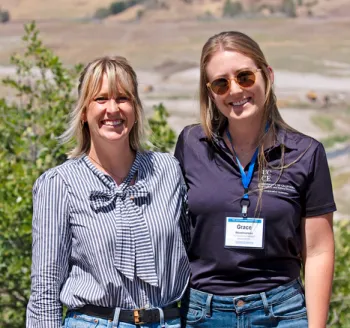
When the earthen dam was removed, sediment was released, initially killing fish and causing the community of Copco Lake to lose the lakefront property they had long enjoyed. Tourists who used to recreate on the reservoir are going elsewhere and the regional economy has been negatively affected. This may turn around, however, the issues are complex and a great deal of work remains.
“There’ve been university scientists working on these issues for several years,” said Rob Wilson, who has been the county’s UCCE agronomy and pest management advisor for 16 years. “We’ve had a lot of researchers working on water quality. We’ve had a lot of researchers working on the fisheries. We’ve had a lot of researchers working on the impacts to agriculture.”
Help for farmers and ranchers
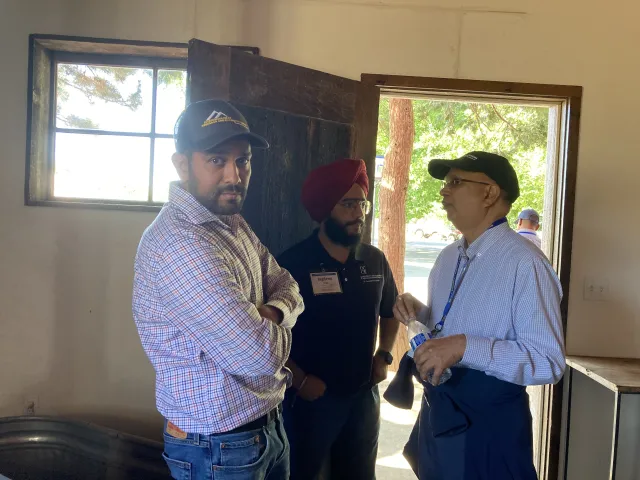
The group also visited Pastures of Grace Ranch, where they were joined by Siskiyou County supervisors and other community leaders. Dinner featured several products grown by Siskiyou County farmers and ranchers – including beef from Crown H Cattle Co., pork from StarWalker Organic Farms, and microgreens by Thunderbird Farms – and the top sirloin main course was barbequed by the Siskiyou County Cattlemen's Association.
Jagdeep Singh, who was celebrating one year as the UCCE agronomy advisor, discussed his research to help growers optimize their irrigation water use. He is collaborating on research to determine evapotranspiration rates for specific regions within Siskiyou County so growers will know more precisely how much water their plants need. Major crops in the region include alfalfa, orchard grass, strawberry starts, triticale and barley.
Woodmansee described the Siskiyou County Livestock Pass Program, which she spearheaded to help livestock producers to care for their animals during wildfires. The program, which has been established in most California counties, is a county-specific partnership involving local, state and federal agencies.
“This multi-agency partnership is critical to bridge communication between private and public land managers during an emergency, as many local ranchers graze their cattle on public lands during wildfire season,” she said.
During a wildfire, emergency evacuation of large-scale ranches is not possible and livestock must instead shelter in place. Woodmansee explained that, in these circumstances, ranchers must be easily identifiable to emergency responders so they may be granted access to care for their livestock safely and efficiently. During fire season, she coordinates the program and in the winter, she organizes program trainings for ranchers and agency personnel.
UCCE Siskiyou programs connect with the community
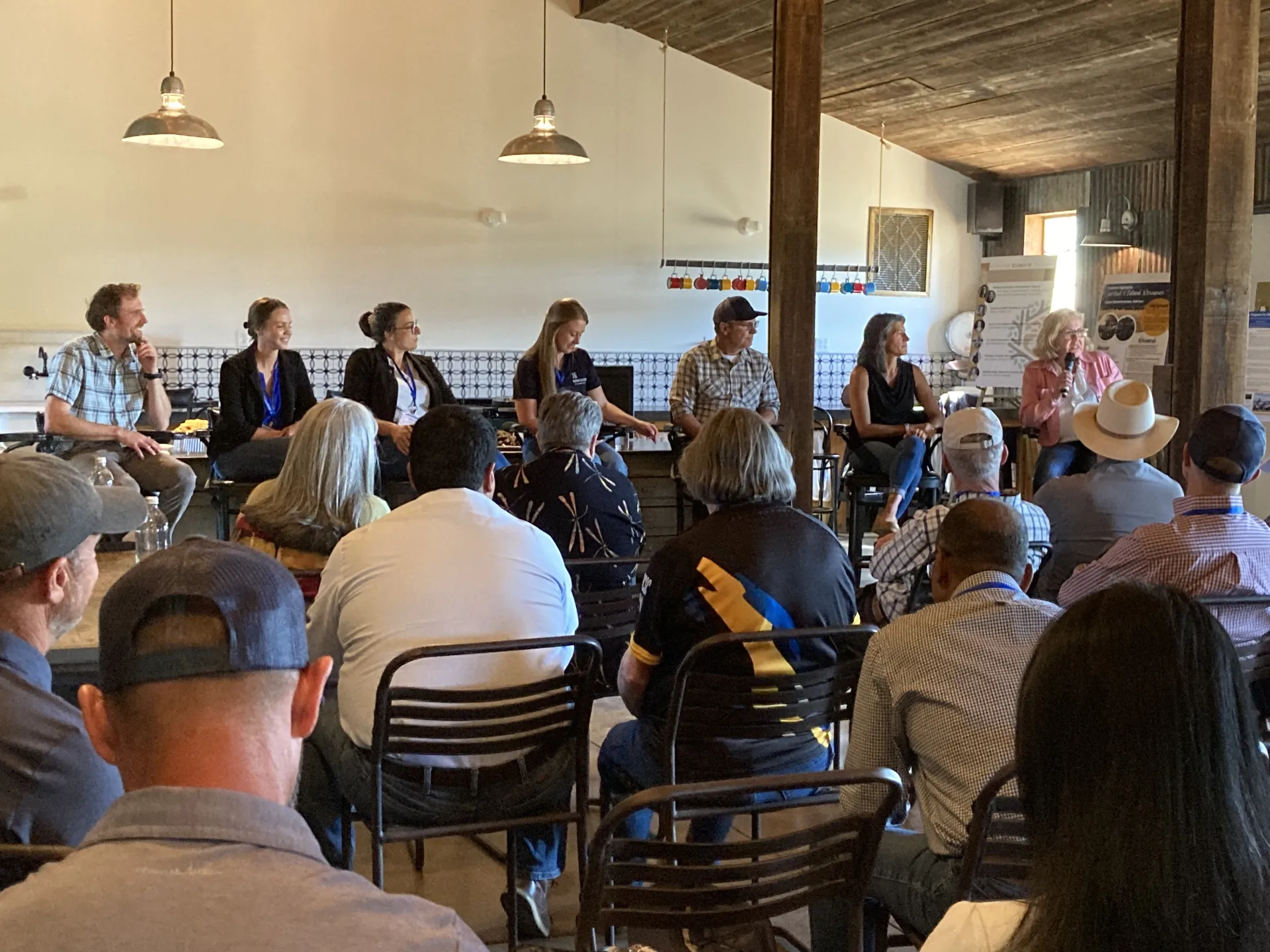
Tonya Dowse, executive director of the Siskiyou Economic Development Council, facilitated a discussion with the Siskiyou Climate Collaborative (SCC), a cross-sectional partnership that is spearheading the development of a community-led Climate Resiliency Plan for Siskiyou County. The panel included Kory Hayden and Emma Morris, Siskiyou Economic Development Council; Justi Hansen, executive director of Siskiyou Outdoor Recreation Alliance; Rod Dowse, Shasta Valley Resource Conservation District manager; Nathan Johnston, facilitator for the SCC; and Woodmansee. As one of six collaboratives funded by the California Strategic Growth Council, the SCC’s work connects the community with resources to adapt to climate-related threats, such as wildfire and drought, while cultivating economic growth.
Humiston added that UC ANR would like to hire a forest products advisor to work on bio-based products and biomass utilization but has not found the right person. This is a high priority for UCCE to support the region’s economic development as is work on enhancing opportunities for outdoor recreation.
Siskiyou County 4-H members Hailee of the Big Springs 4-H Club and Peyton of the Gazelle 4-H Club shared program highlights and described how 4-H has helped them develop life skills. Peyton is enrolling at Modesto Junior College and aspires to be an agricultural lawyer. Hailee, who raises sheep, modeled a red wool crepe top that she had sewn to promote wool marketing.
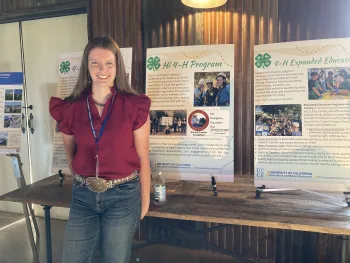
Wolf-cattle conflicts
Wolves have become a threat to cattle in Siskiyou County, said Woodmansee, who noted there are now 10 confirmed wolf packs in California. Because deer and elk populations are limited in the state, cattle have become a major food source for wolves. Siskiyou County’s Whaleback Pack, established in 2021, has unprecedented conflict with livestock and chronic depredation.
Ranchers are limited in how they can respond to wolves attacking their livestock, as wolves are a state and federally listed endangered species. Deterrents such as fladry (flags on rope) and fox lights (flashing lights at random intervals) often fail to prevent conflict when wolves learn there is no negative stimulus associated with them, Woodmansee explained.
While ranchers may be reimbursed for livestock killed if an authorized inspector can confirm that wolves were responsible for the kill (i.e., direct loss), wolf presence also indirectly impacts ranchers when stressed cattle cannot graze normally and gain weight, which can also reduce conception rates and the number of calves born each year. Establishing a stable source of compensation funding is an important first step to address this issue.
UC ANR expands wildfire extension capacity
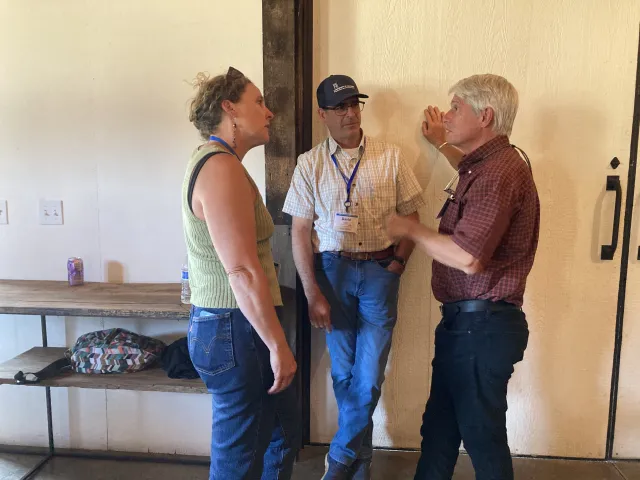
On the second day, Lenya Quinn-Davidson, UC ANR Fire Network director, joined the group to explain how UC ANR has expanded its capacity to address wildfire issues around the state. In 2016, Quinn-Davidson was hired as the first UCCE fire advisor. In 2017, she and UCCE livestock and natural resources advisor Jeff Stackhouse led the formation of the first Prescribed Burn Association in California to show landowners how to use fire as a management tool. In 2023, the Fire Network was established and now has six advisors located throughout the state, and 30 prescribed burn associations have been established. They work with UC Master Gardener volunteers to make communities more resilient through defensible space, fire-resistant landscaping and home hardening.

Another stop, the Lower Klamath National Wildlife Refuge Complex, was established by President Theodore Roosevelt in 1908 as the nation's first waterfowl refuge. A variety of ducks and other shorebirds descended on the wetlands – an increasingly common sight as the dam removal allows more water to flow into the refuge, said John Vandenburg, U.S. Fish & Wildlife supervising biologist.

Erek Fuchs, director of water policy for the Klamath Water Users Association, explained that this year the county’s 200 farms and ranches will have enough water to meet their needs, but are experiencing an increase in the volatility of water supplies. He said data from UC research will help growers adapt to farming with less water.
IREC wheat, potato variety testing
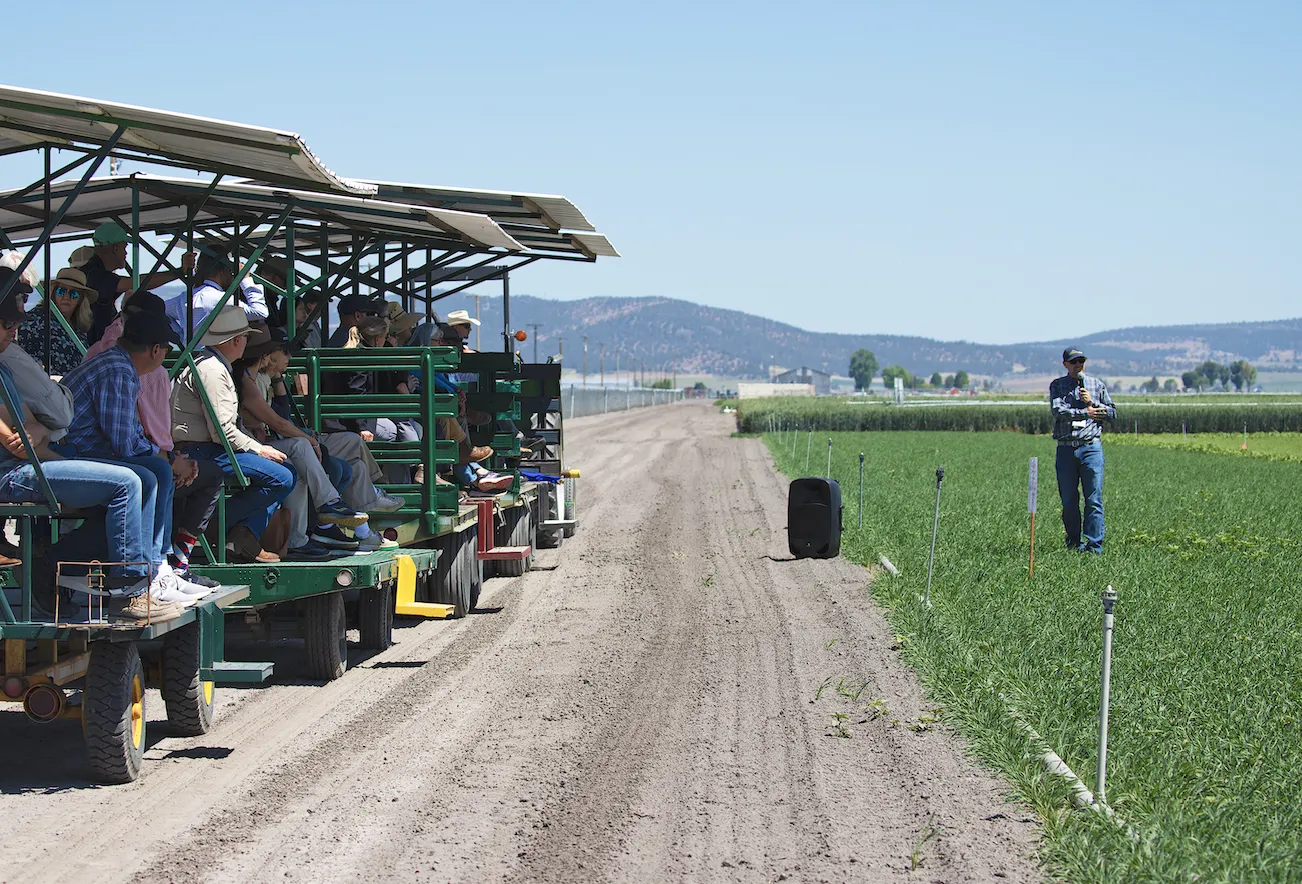
Closing out the second day, the group toured Intermountain Research and Extension Center, or IREC, located in Tulelake.
The Newlands Reclamation Act of 1902 authorized the drainage of Tule Lake to create new farmland. Construction of the Tulelake reclamation project started in 1905 and finished in 1962. In 1917, the U.S. Reclamation Service (later the Bureau of Reclamation) offered a lottery of 3,000 acres for homesteading within the Klamath Reclamation Project. Additional lotteries for homesteading were offered to U.S. military veterans shortly after World War I and World War II. The homesteaders faced many challenges due to the area's isolation, challenging weather and short growing season. In 1947, a cooperative agreement between the Bureau of Reclamation, Tulelake farmers and the University of California established the Intermountain Research and Extension Center. Research done by UCCE was critical to help identify crops that would grow well in the Tule Lake Basin.
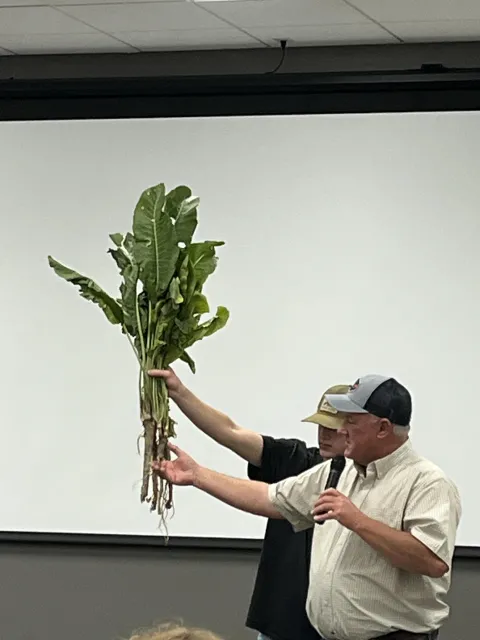
“Horseradish was one of the things they focused on,” local farmer Scott Seus said. “They did trials here; they put in different varieties of horseradish.” A Czechoslovakian variety brought by immigrants performed best and it is still the dominant variety grown today. Seus, who grows horseradish, brought two varieties – the Czechoslovakian variety being a little spicier – for the group to taste with corned beef at lunch.
In the IREC conference room, Darren Haver, director of the Research and Extension Center System, gave an overview of the UC ANR REC system.
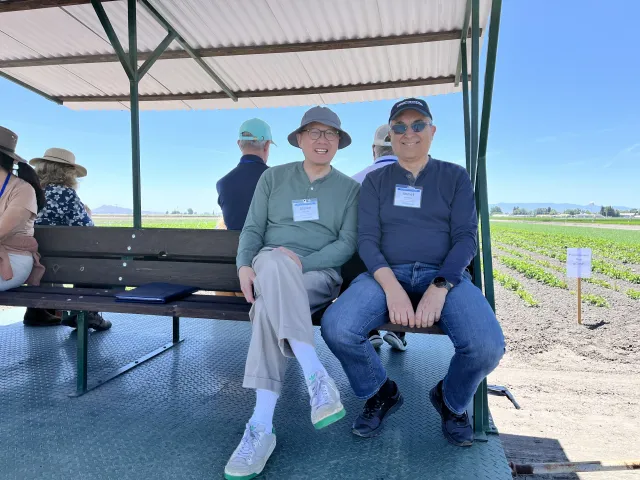
IREC Director Rob Wilson discussed the crops grown in the area, beginning with strawberry nursery production in Butte Valley. Over 50% of California’s strawberry starts are grown in Butte Valley, many of which are UC-licensed varieties. The location’s high elevation and cold weather create perfect conditions to trigger strawberry plants to store carbohydrates in their roots to maximize early season vigor before the bare root plants are planted as seedlings in commercial strawberry fields on the Central Coast.
Laura Snell, director of UCCE in neighboring Modoc County and Livestock and natural resources advisor, gave an overview of UCCE activities, including bringing in retirees as mentors for trainees, UC Master Food Preserver classes, and her research on on-farm composting to dispose of dead livestock that might otherwise attract wolves and other predators.
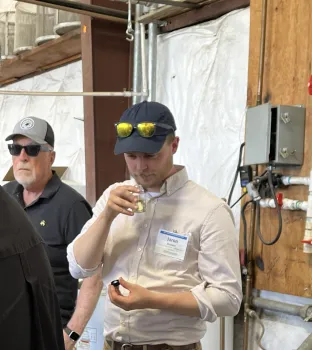
Out in the IREC fields, the group rode a tram as Wilson continued to describe the research. IREC evaluates wheat and potato varieties. It also grows foundation seed to plant for commercial production. The rich, silty clay loam of Tulelake produces 5 to 6 tons per acre of small grains, whereas the state average is 2 to 3 tons.
Organic potato grower Marc Staunton said his family has benefited from IREC potato research. In 2005, to reduce nematodes and verticillium, then UCCE advisor Harry Carlson suggested flooding infested fields to a natural state of wetlands. “It was extremely successful” in driving down disease pressure and increasing fertility, said Staunton, who noted that they still rotate blocks of farmland into wetlands. For future research, he is interested in technology that saves time, like using a drone to scout fields instead of walking them.
Mint is another crop grown in Siskiyou County. It is used for flavoring toothpaste, gum, tea and ice cream. Wilson showed the PAC and Governing Council members IREC’s mini-still for extracting mint oil. Mint grower Scott Seus said mint oil is tested for about 400 chemicals, so they pull weeds that may contaminate the crop.
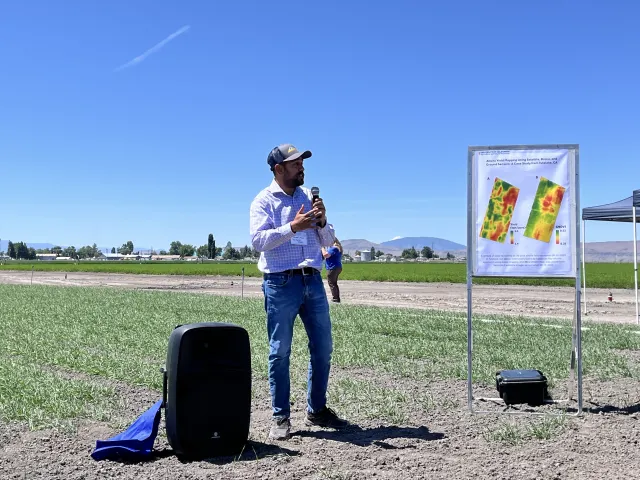
Ahmed Kayad, UCCE agricultural engineering advisor, is using drones and sensors to collect data on alfalfa, wheat and potatoes. From the data, he generates yield maps that show high yield in green and low yield in red. Because weeds steal nutrients and water, he said, growers can use the images to spray spots with high weed density, rather than the whole field and reduce herbicide use.
The tour ended with a lunch featuring local farm products and much discussion of all that had been seen.
“While these groups meet quarterly on Zoom, it’s extremely valuable to have these annual field trips to examine the work that UC ANR does in the field and hear from various stakeholders,” Humiston said. “This improves the ability of the UC President’s Advisory Commission, and the Governing Council, to understand the needs of California’s various regions and better advise on how best to serve the mission of UC ANR.”
Plans are underway for next year’s tour to visit the Sierra Foothill REC and Blodgett Research Forest.

